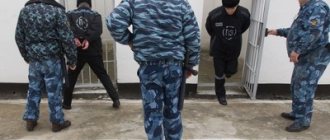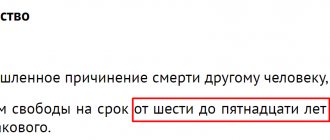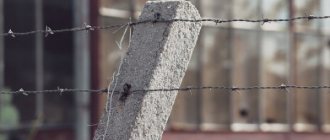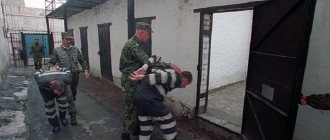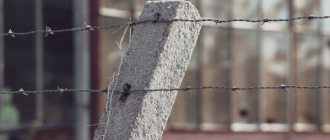Researchers about Russia, that is, the penetration of the culture and morals prevailing in places of detention into ordinary life. The modes of serving sentences raise many questions, including strict and general. In the public consciousness there is an opinion that they are significantly different from each other. Is this really so and which regime is considered more loyal to the convicted person?
A general regime colony is a closed correctional institution where adults are kept in respect of whom a court conviction has entered into legal force. They can be convicted of serious crimes committed for the first time, as well as for crimes of minor and medium gravity, if the court considers it impossible to correct the convicted person in a colony-settlement. The general regime is considered one of the most common in Russia and applies to men and women.
A maximum-security colony is a closed-type correctional institution that houses individuals who pose a high danger to society and require strict restrictions for correction. They were convicted of committing especially serious intentional crimes, committed for the first time, or for simple and dangerous recidivism of crimes. The conditions of stay in such an institution are quite harsh and include many restrictions and complete isolation from society.
Main
So, recently, many Russian citizens have been very interested in the question of how a strict regime differs from a general regime. In fact, their differences are very significant. After all, those who have committed serious crimes for the first time are sent to a general regime colony. Strict - only repeat offenders and those who committed a very serious criminal act for the first time. In addition, it should be said that these two regimes are very different from each other in that one has more relaxations than the other.
Of course, people working in correctional institutions know that in general everything is much simpler than in strict ones. Nevertheless, according to many experts and former prisoners themselves, the harsher the conditions, the faster the correction occurs.
What is the difference between a colony and a settlement colony?
In any correctional colony, be it for minors, women or men, conditions of detention are many times stricter than in a free settlement. This is already a place of mass isolation of people who have committed socially dangerous criminal acts. Correctional colonies and prisons are separated from the rest of society by several security lines: high concrete fencing with barbed wire and observation towers, a staff of wardens and guards with dogs, window bars and door locks.
The second thing that distinguishes a colony from a colony-settlement is location. While checkpoints are predominantly located near populated areas where convicts can find work, penal colonies are in the vast majority of cases located far from villages and towns.
Common to correctional colonies of all regimes is the standard of living space per person (2 m2 for men and 3.5 m2 for women), as well as the zoning and layout of buildings, including living and working spaces, cell-type premises, punishment cells (punishment cells) and places for walking.
More about general mode
The activities of correctional institutions of this type are regulated by the penal legislation of the Russian Federation. In a general regime colony, convicts serve time for serious criminal acts committed for the first time, as well as for crimes of minor and medium gravity, if the judicial authority considers that the correction of such persons is impossible in a settlement. Criminals are sent to this correctional facility only after the sentence comes into force. Until this moment, the latter can appeal the verdict while in a pre-trial detention center or under recognizance not to leave. This is the law.
The general regime is considered one of the most common in our country. Convicted men and women serve their sentences in institutions of this type.
Let's sum it up
- A special regime colony is a specialized institution, originally built and intended exclusively for the complete isolation of people convicted of particularly serious crimes.
- The following categories of violators are admitted to the colony: repeat offenders, prisoners sentenced to life by the court, “death row” prisoners, as well as prisoners placed in more strict conditions by decision of the prison administration.
- Criminals who are serving sentences imposed by the court are kept in different conditions - ordinary, strict, light or especially strict.
- Each mode has its own security measures. They are aimed at reducing the possibility of escape to zero.
- If a prisoner shows ideal behavior throughout the year, he has the right to count on redirection to a colony with loyal conditions of stay.
- There are currently no women's colonies with a special regime.
Maximum security prison
This is a closed colony. Only men who pose the greatest danger to society serve their sentences here. In a maximum security prison there are persons who have committed very serious criminal acts for the first time, as well as dangerous repeat offenders.
The conditions for serving a sentence in this institution are very harsh and include complete isolation from society. Nevertheless, former convicts believe that it is much easier to “sit” in a strict regime than in a settlement. After all, you don’t have to work here, but the state will still provide food and clothing.
It should also be noted that only men can serve sentences under strict regime. This type of correctional facility is not assigned to women. Because the law does not provide for this. Most likely, this is due to the peculiarities of female psychology. After all, the fair sex is much more impressionable than men. Therefore, serving a sentence under harsh conditions is unlikely to benefit them. It should also be noted that even if a woman has committed several very brutal murders, she will still be sent only to the general regime. Moreover, in Russia girls are not given life sentences. You need to know about this.
What is a special detention center?
Another penitentiary, i.e. A correctional institution of the Russian Federation, part of the structure of the Ministry of Internal Affairs of the Russian Federation, is a special detention center. It contains persons sentenced to administrative arrest. According to Art. 3.9. Code of Administrative Offenses of the Russian Federation, this type of punishment is prescribed for the most serious offenses (malicious disobedience to a lawful order or requirement of a police officer, petty hooliganism, etc.), if other punishments, such as a fine, are not enough. In Russia, the minimum period of administrative arrest is 12 hours, and the maximum is 30 days.
Comparative characteristics
What is the difference between a strict regime and a general regime? The answer to this question is spelled out in Articles 121 and 122 of the Penal Code. A number of restrictions are imposed on convicts of both regimes. This is manifested in the amount of money that can be spent on food and personal hygiene items, in the number of visits provided, and in the receipt of parcels, packages and parcels.
But in a strict and general regime, the perpetrator may be in ordinary, strict or light conditions. This will depend on himself, on his desire to work and improve.
In addition
What is the difference between a strict regime and a general regime? This question is most often of interest to those citizens whose loved ones and acquaintances, by the will of fate, find themselves in places of isolation from society. So, under normal conditions, general regime prisoners can spend the funds in their accounts in the amount of no more than three minimum wages within one year. On the strict level it is even stricter - no more than two times the minimum wage. Thus, prisoners must eat mainly the food they are offered in the canteen.
In addition, when serving a sentence in a general regime colony, convicts have the opportunity to receive only four long-term visits and 6 short-term ones. On the strict level there are even fewer - only three of each type during the year. It should also be noted here that visits are granted mainly to close relatives. Although, with the permission of the head of the colony, even an “unofficial” spouse or friend can see the convicted person. Those who are planning to visit a convicted person in a colony need to know about this.
It must also be said that when comparing general and strict regimes, there is a difference even in the number of transfers that a prisoner can receive. After all, everywhere has its own conditions and procedures. In addition, most PSs adhere to the norms of current legislation.
If in a general regime a prisoner can receive six parcels and 6 parcels within one year, then in a strict regime - only four of each type. Thus, the differences here are very significant.
Conditions of detention
Within the colony there are 500 – 3000 convicts.
The territory is divided into two different zones:
- industrial. There are industrial premises located here, where work areas for convicts are organized;
- residential. It is divided into separate plots with living areas located on them. These living areas are delimited based on living conditions.
Those who are subject to a strict regime are mainly kept in isolated cells. In total, there are 20-50 convicts in one such room. If we talk about the general regime of detention, convicts here live in dormitories.
In this case, there can be 20-150 convicts in the room. Criminals serving life sentences live in a cell designed for one or two people.
Usually two- and three-tier bunks are used. The law determines the minimum standard of living space for colonies - two square meters per prisoner.
All prisoners wear the same uniform. A group of prisoners of 150 to 200 people is called a squad. There is a division into several residential zones.
There are separate rooms with lockers placed in them for the purpose of storing your belongings. There are also changing rooms for changing outerwear and shoes. There are canteens and places for personal hygiene.
General
Many people who are interested in the question of why they are given a strict regime should know that they only end up in such correctional institutions for very serious criminal acts. For example, if an attacker has already served a sentence for taking the life of another person, and again committed the same act at a time when the criminal record had not yet been expunged, then he will be considered a repeat offender. Consequently, the judicial authority will send him to serve his sentence only under strict conditions.
If a person has committed an act for the first time, the sanctions for which exceed ten years in isolation from society, for this the perpetrator will also be sent to a strict regime. There are no prisoners here who simply shoplifted bread or punched another person in the face.
Therefore, when answering the question of why a guilty person is sent to a maximum security colony, for what crimes, it is necessary to turn to the norms of the current law. The Penal Code states that citizens who committed very serious acts for the first time, as well as repeat offenders, serve their sentences in such institutions. Even with excellent behavior and performance, convicts under strict regime are not always given parole. However, they are transferred to easier living conditions.
What crimes do they get there for?
If the sentence is served under standard conditions, but the prisoner’s behavior leaves much to be desired, he maliciously violates the established order and law, and he is redirected to a colony with a strict regime.
It is necessary to consider each case separately and give examples:
- a crime qualified as serious has been committed. Such illegal acts carry a penalty of up to 10 years in prison. For example, if a criminal killed someone, attempted on someone’s life, raped a minor, severely beat a person, committed a kidnapping, etc.;
- an illegal act classified as especially serious has been committed. Such intentional crimes are punishable by imprisonment for a period of more than 10 years, or a more severe punishment is chosen. For example, a criminal raped a victim, which resulted in her death, a murder of a person was committed followed by dismemberment of the corpse, large-scale theft of state property and funds, etc.;
- the offender has repeatedly violated the law and committed a criminal offense. In this case we are talking about relapse (Article 18 of the Criminal Code of the Russian Federation).
conclusions
So, it has now become clear that the general and strict regimes are very different from each other. First of all, this is manifested in the fact that those convicted who violated the procedure for serving their sentence in a colony settlement often end up in general. This happens in practice very often. Therefore, we should not forget that in the general regime, unlike the strict regime, there are no repeat offenders. Those people who committed acts of minor or moderate gravity are still serving their sentences here, but, according to the court, the latter cannot be in the settlement. Thus, we can conclude that the difference between the general regime and the strict regime is that there is a different contingent there. It is very important.
Convicts under strict regime cannot spend more than two minimum wages of money during the year on their needs from their personal account. Thus, they are forced to eat and use what is given in the colony.
In general mode everything is a little simpler. Moreover, many people here receive early release after a certain amount of time. Some are transferred to settlements for good behavior. There, the convicts serve the remainder of their sentence. This is a very good prospect for those who want to improve and return home quickly.
List of institutions
Regardless of the severity of the institution's regime, most of them have names that are inappropriate in their sonority.
Attention! There are only seven such prisons on the territory of the Russian Federation:
- Mordovian colony. 200 prisoners are serving their sentences here. Most of them are maniacs, as well as serial killers;
- Black Dolphin. The prison is located in the town of Sol-Iletsk (Orenburg region). The institution received such a colorful name because of the figurine of a black dolphin sculpted by the convicts;
- Polar owl. Location – village of Kharp (outside the Arctic Circle). The temperature there is almost always low, around -40 degrees. Escape from this place seems almost pointless. This is the place of detention of the Bitsevsky maniac A. Puchushkin;
- Black golden eagle. The institution is located in the northern part of the Sverdlovsk region. The colony got its name from a sculpture made by one of the prisoners. She depicted a black golden eagle holding a snake in its claws. Most prisoners are homicidal maniacs;
- White Swan. Location – Solikamsk. It was named so because of the local way of moving prisoners - in the “swan pose”. When moving, the convicted person leans forward, while raising his hands clasped together behind his back. The most famous among the prisoners is Salman Raduev (terrorist);
- Vologda nickel. Located on an island territory. Escapes from here are impossible;
- Torbeevsky Central. Location: Republic of Mordovia. Here the convicts are detained only for a while, then they are distributed to other colonies.


